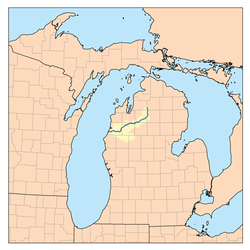Manistee River
| Manistee River | |
|---|---|
 |
|
| Basin features | |
| Main source |
Mancelona Township, Antrim County, Michigan 1,250 ft (380 m) 44°56′06″N 84°52′06″W / 44.93501°N 84.86837°W |
| River mouth |
Lake Michigan 579 ft (176 m) 44°15′00″N 86°20′40″W / 44.25°N 86.34453°WCoordinates: 44°15′00″N 86°20′40″W / 44.25°N 86.34453°W |
| Basin size | 1,780 sq mi (4,600 km2) |
| Physical characteristics | |
| Length | 190 mi (310 km) |
The Manistee River in the U.S. state of Michigan, runs 190 miles (310 km) through the northwestern Lower Peninsula; it now passes through the contemporary villages of Sharon, Smithville, and Mesick, entering Lake Michigan at Manistee. It is considered, like the nearby Au Sable River, to be one of the best trout fisheries east of the Rockies.
The river rises in the sand hills in southeastern Antrim County, on the border with Otsego County, about 6 miles (10 km) southeast of the town of Alba. These deep glacial sands provide it with a remarkably stable flow of clean cold water year round, making it a popular river for fishing as well as canoeing. Over the course of its length, it drops in elevation from around 1,250 to 579 feet (381 to 176 m), with an average stream gradient of about 2.9 feet per mile (55 cm/km).
The name "Manistee" is from an Ojibwe word whose derivation is uncertain. However, it may be from ministigweyaa, "river with islands at its mouth". The Ojibwe (Chippewa in the United States) and Ottawa peoples lived along the river, with the Ottawa having a reservation on the river from 1836. The federally recognized Little River Band of Ottawa Indians continues to occupy its reservation in Manistee County, as well as lands in Mason County.
Historically, the upper river was renowned for its outstanding grayling fishery, among the finest in the world. Catches in excess of 1000 fish per weekend outing were commonly reported up until the 1880s, when extensive logging in the area ruined the streams and habitat. Logging in the area commenced in earnest by European-American settlers between 1880 and 1910, with peak production occurring in the 1890s. Logging denuded habitat areas, with silt runoff and logging debris degrading the water quality of the river.
...
Wikipedia
